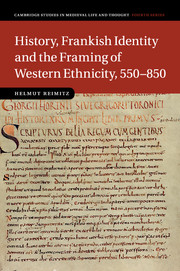Book contents
- History, Frankish Identity and the Framing of Western Ethnicity, 550–850
- Cambridge Studies in Medieval Life and Thought
- History, Frankish Identity and the Framing of Western Ethnicity, 550–850
- Copyright page
- Contents
- Figures
- Maps
- Tables
- Preface and acknowledgements
- Introduction
- Part I Communities of the middle ground in sixth-century Gaul
- Part II Countermyths
- Part III A common future
- Conclusion
- Bibliography
- Manuscripts
- Primary sources
- Secondary works
- Index
- References
Secondary works
Published online by Cambridge University Press: 05 August 2015
- History, Frankish Identity and the Framing of Western Ethnicity, 550–850
- Cambridge Studies in Medieval Life and Thought
- History, Frankish Identity and the Framing of Western Ethnicity, 550–850
- Copyright page
- Contents
- Figures
- Maps
- Tables
- Preface and acknowledgements
- Introduction
- Part I Communities of the middle ground in sixth-century Gaul
- Part II Countermyths
- Part III A common future
- Conclusion
- Bibliography
- Manuscripts
- Primary sources
- Secondary works
- Index
- References
- Type
- Chapter
- Information
- Publisher: Cambridge University PressPrint publication year: 2015



